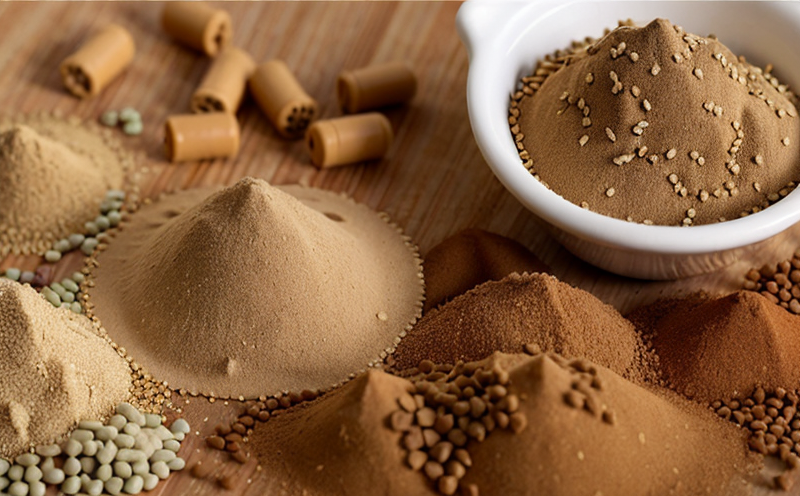Enrofloxacin Residue Testing in Animal Feed
The presence of veterinary drugs, including enrofloxacin, in animal feed can pose significant risks to both the health and safety of livestock and consumers. Enrofloxacin is a fluoroquinolone antibiotic commonly used for treating bacterial infections in animals. However, its residues left behind after treatment can accumulate in animal products like meat and milk, leading to potential food safety hazards.
Our laboratory provides comprehensive testing services for enrofloxacin residue detection in animal feed, ensuring compliance with international standards such as ISO, ASTM, and the relevant regulations of the European Commission. This service is particularly important for quality managers, compliance officers, R&D engineers, and procurement teams who must ensure that their products meet stringent safety standards.
Testing involves a meticulous process starting with the collection of feed samples. Samples are then prepared using methods that minimize contamination and distortion. Once prepared, they undergo rigorous analysis to determine enrofloxacin levels. The results provide critical insights into whether the product is safe for use in animal production processes.
The significance of this testing cannot be overstated. Accurate identification of enrofloxacin residues helps prevent contamination issues that could lead to recalls and other costly consequences. For instance, a single positive test result can halt entire batches, causing financial losses and reputational damage if not caught early on.
Our laboratory adheres strictly to international guidelines during every stage of testing. This ensures consistency across different environments while maintaining high standards of accuracy and precision. By leveraging advanced analytical techniques like Liquid Chromatography-Mass Spectrometry (LC-MS/MS), we achieve reliable results that are repeatable and reproducible.
Understanding the implications of enrofloxacin residue testing is crucial for those involved in agricultural practices or related industries. Properly conducted tests not only protect public health but also safeguard the integrity of supply chains by ensuring adherence to regulatory requirements.
Scope and Methodology
| Aspect | Description |
|---|---|
| Sample Collection | Feed samples are collected from various sources to ensure broad representation. |
| Preparation | Involves homogenization, extraction methods using solvents, and cleanup steps if necessary. |
| Analytical Techniques | Liquid Chromatography-Mass Spectrometry (LC-MS/MS) is used for precise quantification of enrofloxacin residues. |
| Quality Control | Incorporates internal standards, blanks, and spiked samples to validate analytical methods. |
| Acceptance Criteria | Description |
|---|---|
| Maximum Residue Limit (MRL) | The maximum allowable concentration of enrofloxacin in feed as per ISO standards. |
| Statistical Significance | Determination based on repeated measurements to ensure reliability and consistency. |
| Reproducibility | Ensures that the results are consistent across different laboratories performing similar tests. |
Benefits
The benefits of enrofloxacin residue testing in animal feed extend beyond mere compliance; they contribute significantly to enhancing product quality and consumer confidence. By identifying and eliminating contamination early on, businesses can avoid costly recalls and maintain their reputation for reliability.
For quality managers, these tests offer peace of mind knowing that every batch meets strict regulatory requirements. Compliance officers benefit from having robust data supporting adherence to international standards. R&D engineers gain valuable insights into potential sources of contamination which could inform future product development efforts.
From an operational perspective, accurate residue testing ensures efficient supply chain management by preventing delays caused by non-compliant batches. Additionally, it supports sustainable agricultural practices by promoting responsible use of veterinary drugs.
In summary, our enrofloxacin residue testing service is designed to provide comprehensive support for stakeholders across the entire animal feed industry. It plays a vital role in maintaining safety standards while fostering trust among consumers and regulators alike.
Quality and Reliability Assurance
We take pride in our commitment to delivering accurate, reliable results through rigorous quality assurance measures. Our team of experts follows strict protocols throughout the testing process to ensure that each sample is handled carefully from collection to final analysis.
A key aspect of our approach is regular calibration and validation of equipment using certified reference materials. This ensures that all instruments are operating within specified tolerances before every test run. We also conduct internal audits at periodic intervals to assess performance metrics such as turnaround times, error rates, and customer satisfaction levels.
To further enhance reliability, we participate in proficiency testing programs organized by recognized bodies like the ISO. These external evaluations provide independent verification of our capabilities and help maintain high standards continuously. Furthermore, continuous education and training sessions are provided for staff to stay updated on latest technological advancements and best practices.
By integrating these elements into our workflow, we aim to deliver consistent, trustworthy results that meet or exceed expectations set by industry stakeholders worldwide.





